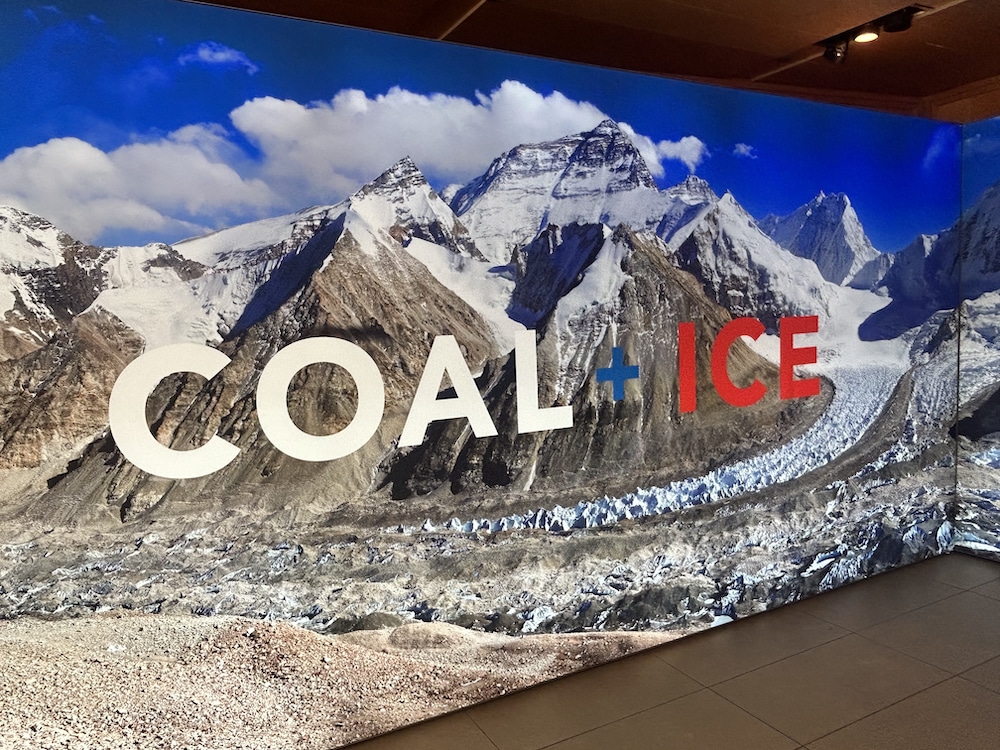This post was originally published on Eco Watch
“Coal is the heart and soul of modernity.” Orville Schell is talking about the long history of coal mining, as represented in a major section of the exhibit “COAL + ICE” on view in New York City through August 11. Schell is vice president of the Asia Society, where the exhibit is mounted, and coal was the exhibition’s catalyst.
Craig Thompson
Back in the 2000s, Schell and Susan Meiselas, this exhibit’s co-curator, had been collecting coal mining documentary photographs from China in the 2000s. When they first visited the coal mining areas, Schell was stunned by the landscape before him. “It was completely defoliated, the sky was gray, with piles of coal everywhere,” he says. “It was an invocation of what happens when coal is king. The river was polluted, the air was polluted.”
But after collecting images of the coal industry in China, Schell connected with a mountain photographer who had ascended Tibet numerous times. “He kept saying that the glaciers are melting.” The melting glaciers are having an undeniable impact on the rivers, and the people, living downstream. After Schell saw firsthand these two major environmental catastrophes, COAL + ICE was born.
“The coal was the largest emitter of carbon dioxide, a kind of metaphor for fossil fuels, and the Tibetan plateau, the third pole, was the ice part of it,” Schell says. COAL + ICE was first mounted in 2011 in Beijing. And one of those photos from that time is mounted here.
“He’s a Chinese coal miner named Song Chao from Shandong Province,” Schell says. “His uncle was a photographer for the new China news agency, so he could get his hands on a camera, and he started shooting portraits of his workmates. And they’re stunningly beautiful.”

Song Chao
Coal has historically been the highest emitter of CO2 on Earth. Today, China leads the way by a large margin – in 2023, according to Global Carbon Budget data, the country emitted 8.25 billion tonnes of CO2, a number that continues to grow. China currently accounts for about 60% of the world’s coal use, while the country undergoes the dichotomy of increased coal plant approvals and a massive investment in solar and wind power. The exhibit contains a powerful section of video and images that shows the scale of coal production in China, with a nod to American history as well.

Craig Thompson
Since the first show in 2011, sections have been added. The first was a series of photos on consequences – hurricanes, flooding, and fire – and more recently, a section on solutions was added.

Craig Thompson
In one powerful section at the Asia Society, Gideon Mendel’s photos are presented on four panels. Mendel is a photographer who traveled around the world to where floods had occurred. He followed people home after the deluge, as they were wading home and as they got to their doors. His images show the powerful aftermath of the floods.

Craig Thompson

Craig Thompson
Clifford Ross is an artist who shot hurricane waves, both on Long Island and off the coast of Portugal, at the famous Nazare shelf. He discovered that “the artist, namely me, who thought he was photographing nature… wasn’t just photographing nature, but nature stirred and shaken by man’s intervention.”

Clifford Ross
But the solutions section of the exhibition attempts to shed some positivity on the subject. One of the images is by James Stillings, a photographer who used planes and drones to fly over renewable energy projects. “They’re kind of strikingly beautiful, and sort of designed,” Schell says. “You get a sense of the scale of it. You get a sense that we know exactly what to do, we’re just not doing enough of it.”

James Stillings
An installation called New York, 2050: A Possible Future shows “what New York could look like in 2050, with ocean levels a couple of feet higher,” notes Schell.

Craig Thompson

Craig Thompson
The show has been around the globe, to Delhi, Copenhagen, Paris, Aspen, San Francisco, Washington, DC, and Shanghai.
“We thought maybe visually, we could get to them,” says Schell. “It’s an effort to try to present the climate challenge in ways that are not truly didactic in written form. Once you get people into the tent, they do become engrossed in it. You just hope to wake them up a little.
“I think we all feel deeply discouraged. But on the other hand, we also know we need to do something.”
COAL + ICE is showing through August 11 in New York City at the Asia Society. For more information: https://asiasociety.org/new-york/exhibitions/coal-ice
The post COAL + ICE: An Expansive Climate Breakdown Exhibit appeared first on EcoWatch.





0 Comments